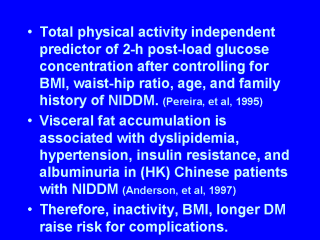| front |1 |2 |3 |4 |5 |6 |7 |8 |9 |10 |11 |12 |13 |14 |15 |16 |17 |18 |review |
 |
Pereira et al,
1995, reported that the best independent predictor of 2 hour post-load glucose (glucose
tolerance test), after adjusting for the effects of adiposity, age and family history of
NIDDM was total amount of physical activity. The message is, then, that if you allow yourself to get fat and inactive, you increase the risk of hazardous lipid profile, insulin resistance, renal damage and hypertension (Metabolic Syndrome). Regular and adequate exercise and moderate, careful eating seem to be protective against developing NIDDM. However, if, after a life of driving in a Mercedes-Benz, eating dim sum each day and buffets every night for forty years, you already have NIDDM, what can you do to avoid the complications? Good insulin control is currently believed to be important. Dietary control to reduce calorie intake and increased exercise and general activity are the main strategies. However, most people are indolent because they are physically so deconditioned that exercise seems too much like hard work, and they have grown use to a life of under-exertion. So most will not suddenly begin to do a sufficiently intense graduated exercise programme and shift to a lower fat vegetarian diet. Nonetheless there is some research evidence to indicate weight loss, reduction in adiposity and improved diet may help reverse NIDDM and stabilize the development of conditions predisposing to complications. |
| front |1 |2 |3 |4 |5 |6 |7 |8 |9 |10 |11 |12 |13 |14 |15 |16 |17 |18 |review |